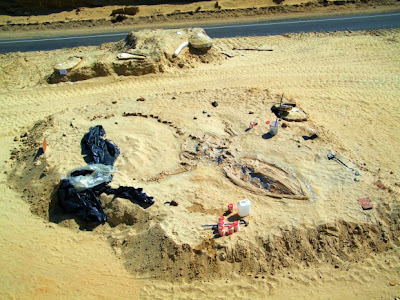Monday, 21 November 2011
Massive Whale Fossil Graveyard In Chile
The Blaze: Giant Whale Graveyard Found in Chilean Desert
"But how did they get there? That’s the question paleontologists are trying to figure out.
Maybe they became disoriented and beached themselves. Maybe they were trapped in a lagoon by a landslide or a storm. Maybe they died there over a period of a few millennia. Somehow they ended up right next to one another, many just meters (yards) apart, entombed as the shallow sea floor was driven upward by geological forces and transformed into the driest place on the planet."
How did they get there? Easy! The same way most of the massive fossil graveyards got there. Two words. Genesis Flood.
"the Chilean fossils stand out for their staggering number and beautifully preserved bones. More than 75 whales have been discovered so far — including more than 20 perfectly intact skeletons.
“I think they died more or less at the same time,” said Nicholas Pyenson, curator of fossil marine mammals at the Smithsonian’s National Museum of Natural History."
One of the main theories of the scientists investigating this fossil graveyard is that the whales (75 of them) got caught in a huge landslide. This "local but large landslide" explanation pops up constantly as an explanation for many of the world's fossil graveyards because fossils require a very special set of circumstances to form.
A lot of people don't realize just how fragile and easily destroyed a potential fossil is. For a fossil of a biological creature to form, that creature has to have been completely buried mere moments after its death or while it's still alive. This is because in a matter of hours bacteria and other organisms start to attack a recently dead creature and break it apart. Also, the only way a fossil can form is if it is completely covered by sediment. Over many years the bones then get transformed through chemical reactions within the sediment and become hard preserved fossils. Bone fossils of once living creatures cannot form any other way.
While secular scientists are shocked by large fossil graveyards all over the planet, scientists that believe in the trustworthiness of the Holy Bible are not at all surprised by such finds. The great world wide flood described in Genesis is the perfect explanation for fossil graveyards and for many of the changes to the world's geology since. Here are just a couple reasons why...
Sediment: Sediment covers most of the earth and is mostly formed and transported by way of water, wind and glaciers. Sediment is small particles of earth or sand that have been compressed or dried out together to form Sedimentary Rock. Since most sediment is formed through water, the global flood described in the first book of the Holy Bible, Genesis, is a perfect explanation for much of the sediment covering the earth's surface. In the flood, water covered the whole earth turning mass quantities of soil into different layers of sediment in a matter of a single year. Secular scientists on the other hand, believe that the earth's sediment has been very slowly building up for 2 billion years.
Sediment Holds Fossils: Pretty much all fossils of once living things are buried in Sedimentary Rock. This is why so many of the fossil explanations from secular scientists go to the "died in a landslide" theory. The creature that becomes a fossil must be buried in sediment right away for it to be preserved. This means that it has to be completely covered in loose sediment that over time turns into solid rock. Thus landslides and flash floods are the best explanation for fossils. This is why the Genesis Flood is the best explanation for the vast majority of fossils we find today. In the global flood millions and millions of living things were drowned and buried in a cataclysmic upheaval that moved huge quantities of water across the land. Have you ever seen pictures or movie clips of a flood? Flood water carries tons of sedimentary debris as it rips across the ground and lays down tons of that soft muddy sediment all over the place, often times partially or completely burying anything it comes across, whether alive or not.
While secular scientists use small localized floods and landslides over millions of years to explain most fossils, Christians can easily explain the earth's sediments and the fossils buried within as having been laid down suddenly and dramatically by the world wide flood described in Genesis.
When the water receded, millions of creatures were buried in soft sediment all over the earth. That soft sediment dried out and turned into hard Sedimentary Rock, forever preserving the bones of the creatures that suddenly died and were just as suddenly buried. This means that many of the fossils found today were not buried across hundreds of millions of years of time, but were instead buried very quickly in a matter of a single cataclysmic year. Nicholas Pyenson theorizes that the whale fossils, “died more or less at the same time.” He's right, they did, probably in the global flood.
Labels:
Apologetics,
Fossils,
Genesis Flood,
Geology
Subscribe to:
Post Comments (Atom)

No comments:
Post a Comment